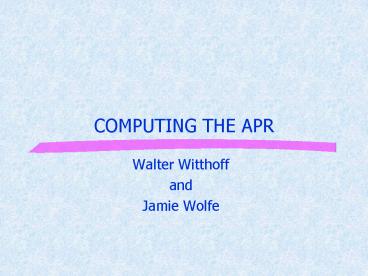COMPUTING THE APR - PowerPoint PPT Presentation
1 / 12
Title:
COMPUTING THE APR
Description:
Actual Day and Equal Month Computation ... or occasionally may be assessed at the point monthly installments commence. ... 360 v.365 days. Compounding of interest ... – PowerPoint PPT presentation
Number of Views:39
Avg rating:3.0/5.0
Title: COMPUTING THE APR
1
COMPUTING THE APR
- Walter Witthoff
- and
- Jamie Wolfe
2
The Annual Percentage Rate
- "The annual percentage rate is a measure of the
cost of credit, expressed as a yearly rate, that
relates the amount and timing of value received
by the consumer to the amount and timing of
payments made. (Regulation Z, Section
226.22(a)(1))
3
Why Is The "APR" Important?
- Civil liability
- Reviews by regulators
4
What's So Special About Student Loans?
- The interim period is a distinguishing
characteristic of student loans and greatly
affects all aspects of disclosure relative to
Regulation Z, including computation of the APR. - It is helpful to view the interim and repayment
intervals as two distinct periods, each having
unique characteristics and requiring two
different APR computations and disclosure
requirements.
5
What do we need to know to compute the Annual
Percentage Rate?
- Terms of the loan
- United States Rule (U.S. Rule) and the Actuarial
Method - Federal Calendar
- Unit Period
- Multiple Advance, Single Payment Transactions
- Prepaid Finance Charges
6
United States Rule and the Actuarial Method
- Appendix J of Regulation Z, which is devoted to
detailed instruction in the art of computing the
APR, focuses almost solely on the actuarial
method. - The U.S. Rule does not require the addition of
accrued interest to the outstanding balance at
the end of the unit period, whereas the actuarial
method does require such capitalization. - Unique to the U.S. Rule is the fact that
Regulation Z leaves the definition of unit period
up to the lender and does not require its use.
7
Unit Period
- General Rule. The annual percentage rate shall be
the nominal annual percentage rate determined by
the number of unit periods in a year."
(Regulation Z, appendix J (b)(1)) - "The unit period shall be that common period
that occurs most frequently in the transaction."
(Regulation Z, appendix J (b)(4)) As an example,
on a loan with monthly payments and no interim
period the unit period would be monthly. - Time intervals Advances and payments.
8
The Federal Calendar
- Relevant only to actuarial method
- Attempt to standardize measuring unit periods
under actuarial method - Equal periods
9
Actual Day and Equal Month Computation
- Under the U.S. Rule the decision whether to use a
360-day (equal month, or 1/12th of a year) or a
365-day (actual day) year is left to the
discretion of the creditor. - With certain exceptions, the actuarial method
under the Federal Calendar (Regulation Z,
appendix J (b)(5)(ii)), requires an equal month
computation.
10
Prepaid Finance Charges (Guarantee or Origination
Fees)
- Generally these fees are deducted from the loan
proceeds, or occasionally may be assessed at the
point monthly installments commence. For purposes
of Regulation Z, such fees are considered prepaid
finance charges. - The creditor must factor any prepaid finance
charge into the calculation of the APR .
11
Tolerances
- Regulation Z, Section 226.2(a)(1)(2)
- Regular transactions. The APR must be no more
than 1/8th of one percent above or below the true
APR. - Irregular transactions (e.g., student loans with
interim periods). The APR must be no more than
1/4th of one percent above or below the true APR.
12
State Law and APR
- Reconciling the Federal Calendar (APR) and state
law (application of rate of interest) computation
methods - 360 v.365 days
- Compounding of interest































